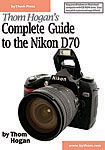Before I go on my rant, I need to give a little background.

When Andrei purchased his Nikon D70, we discovered that we had purchased different eBooks. I had purchased Peter iNova’s book and Andrei had gotten Thom Hogan’s. So after we had read our respective books, we initiated a exchange of CDs.
The two books are very different. Peter’s book capitalizes on features unique to PDF (actually somewhat frustrating since I hate Adobe Reader), is prettier, and doubles as an introductory book on Photography. Thom’s book is more practical (specific camera setting advice), has some nice tips you don’t get elsewhere, and is laser focused on one thing: talking about the Nikon D70. They both come with a bunch of Photoshop Actions, which I haven’t had a chance to use.
What I’m trying to say, in my roundabout way, is that Thom Hogan’s book is really, really good. It’s the user manual that should have been included with the camera.
[Good, I’ve gotten that off my chest. Now let me rant.]
Why do jpegs recover information better from dark areas vs. bright ones?
Why? Because the signal to noise ratio for that pixel value of 1,1,1 is lower than the one with a value of 254,254,254. Let’s examine a hypothetical example to find out why. Let’s say that your camera has random noise “base” that averages 2 photons. Further, let’s assume that the 1,1,1 value represents a photosite that’s captured 100 photos. The signal to noise ratio for that pixel is 50:1. The 254,254,254 value represents capture of perhaps 10,000 photos, so the signal to noise ratio is 5000:1.
—Thom Hogan, “Thom Hogan’s Complete Guide to the Nikon D70.” page 385.
As Joseph would say, “W-T-F, mate?” This footnote from Thom Hogan’s book has me scratching my head because it doesn’t make:
- Common Sense. A higher signal-to-noise is more desired, not less, and a higher signal-to-noise ratio is the bigger number. So by this argument, the photosite with 1,1,1 is less desirable. 1
- Practical Sense. Noise doesn’t exhibit the property that Thom mentions. Or rather, the only noise that I can think of that exhibits that property is thermal noise. What happens in that case is that the heat of the ambient environment causes a leakage current significant enough that the photosites record a value different from what it should. This is why the D70 has a feature called Long Exposure Noise Reduction that will minimize this effect.
- Mathematical Sense. The largest factor of noise in Thom’s example is “shot noise.” In simple terms, the noise level will go as the square root of the number of samples. In Thom’s case, shot noise is 10 (out of 100 photons) for the 1,1,1 site (signal-noise of 10:1) and 100 (out of 10,000 photons) for the 255,255,255 case (signal-noise of 100:1).2
- Physical Sense. CCDs are linear systems,3 but exposures are exponential.4. This means that 2048 of the 4096 levels (12-bit) will be devoted to the highlights in the top f-stop while only 128 or 64 levels will be devoted to the bottom f-stop of resolvable. The dynamic range should be significantly less for underexposed images.
In other words, the statement doesn’t make common, practical, mathematical, or physical sense. It’s wrong. wrong. wrong. wrong.
The problem is we are faced with the reality that it is safer in digital photography to underexpose than overexpose. What’s the right answer?
I don’t know. But here are two guesses:
- The mapping used to map the linear CCD readings into JPEG values is highly nonlinear. This mitigates the effect that CCDs are linear.
- When the CCD reaches the maximum value (4096) in RAW, the rest gets clipped (or “blown out”, meaning all tonal information is lost). But film doesn’t operate this way at all. At very low and high values film saturates very slowly and doesn’t clip. At the low end this results in “reciprocity failure (a bad thing) and I assume there is a similar failure at the high end (a good thing because you can recover the lost tones).
The problem is that if this is true and I am shooting in RAW doesn’t this imply that as long as I don’t clip any highlights I’m even better off than before? And if that is the case, why don’t they build visual feedback mechanisms into the camera review that tell me how many pixels are registered at exactly 40965 since that is the only number I should care about.
Please help!
6 thoughts on ““Blowing” highlights?”